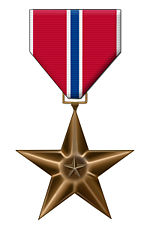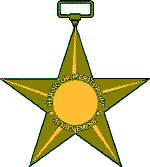Bronze Star Medal
 From Nwe
From Nwe | Bronze Star Medal | |
|---|---|
 |
|
| Awarded by the United States of America | |
| Type | Medal |
| Awarded for | “Heroic or meritorious achievement or service” |
| Status | Currently awarded |
| Clasps | The Valor device identifies the award as resulting from an act of combat heroism |
| Statistics | |
| First awarded | 4 February 1944 (Retroactive through December 7, 1941). |
| Last awarded | Currently awarded |
| Precedence | |
| Next (higher) | Army - Soldier's Medal Navy—Navy and Marine Corps Medal Air Force—Airman's Medal Coast Guard—Coast Guard Medal |
| Next (lower) | Purple Heart |
 Reverse side of the Bronze Star Medal |
|
The Bronze Star Medal is a United States Armed Forces individual military decoration which may be awarded for bravery, acts of merit, or meritorious service. When awarded for bravery, it is the fourth-highest combat award of the U.S. Armed Forces and the 9th highest military award (including both combat and non-combat awards) in the order of precedence of U.S. military decorations. The three other wartime medals ranked higher are: The Distinguished Service Cross, the Silver Star, and The Medal of Honor.
The award recognizes acts of heroism performed in ground combat if they are of lesser degree than that required for the Silver Star. It also recognizes single acts of merit and meritorious service if the achievement or service is of a lesser degree than that deemed worthy of the Legion of Merit; but such service must have been accomplished with distinction.
The Bronze Star Medal is typically referred to by its full name (including the word “Medal”) to differentiate the decoration from bronze service stars which are worn on campaign medals and service awards.
General information
The Bronze Star Medal was established by Executive Order 9419, February 4, 1944 (superseded by Executive Order 11046, August 24, 1962, as amended by Executive Order 13286, February 28, 2003).
The Bronze Star Medal is awarded to any person who, while serving in any capacity in or with the Army of the United States after December 6, 1941, distinguished himself or herself by heroic or meritorious achievement or service, not involving participation in aerial flight, in connection with military operations against an armed enemy; or while engaged in military operations involving conflict with an opposing armed force in which the United States is not a belligerent party. Title 10, United States Code, section 1133, (10 USC 1133) limits award of the Bronze Star Medal to service members receiving imminent danger pay.
Awards may be made for acts of heroism, performed under circumstances described above, which are of lesser degree than required for the award of the Silver Star.
The Bronze Star Medal may be awarded for meritorious achievement or meritorious service according to the following: (1) Awards may be made to recognize single acts of merit or meritorious service. The lesser degree than that required for the award of the Legion of Merit must nevertheless have been meritorious and accomplished with distinction. (2) Award may be made to each member of the Armed Forces of the United States who, after December 6, 1941, has been cited in orders or awarded a certificate for exemplary conduct in ground combat against an armed enemy between December 7, 1941 and September 2, 1945, inclusive, or whose meritorious achievement has been otherwise confirmed by documents executed prior to July 1, 1947. For this purpose, an award of the Combat Infantryman Badge or Combat Medical Badge is considered as a citation in orders. (3) Upon letter application, award of the Bronze Star Medal may be made to eligible Soldiers who participated in the Philippine Islands Campaign between December 7, 1941 to May 10, 1942. Performance of duty must have been on the island of Luzon or the Harbor Defenses in Corregidor and Bataan. Only Soldiers who were awarded the Distinguished Unit Citation (Presidential Unit Citation) may be awarded this decoration.[1]
History
The award that eventually became the Bronze Star Medal was conceived by Colonel Russell P. "Red" Reeder in 1943, who believed it would aid morale if there was a medal which could be awarded by captains of companies or batteries to deserving people serving under them. Reeder felt the medal should be a ground equivalent of the Air Medal, and proposed that the new award be called the “Ground Medal.”[2]
The idea eventually rose through the military bureaucracy and gained supporters. General George C. Marshall, in a memorandum to President Franklin D. Roosevelt dated February 3, 1944, wrote:
The fact that the ground troops, Infantry in particular, lead miserable lives of extreme discomfort and are the ones who must close in personal combat with the enemy, makes the maintenance of their morale of great importance. The award of the Air Medal has had an adverse reaction on the ground troops, particularly the Infantry Riflemen who are now suffering the heaviest losses, air or ground, in the Army, and enduring the greatest hardships.
For Marshall, the Bronze Star was a matter of creating a balance between what the Army Air Forces were handing out and what the ground units could earn. The Air Medal had been approved two years earlier to improve airmen’s morale, but there was no equivalent for the grunts.
"The awards of the Air Medal have had an adverse reaction on the ground troops, particularly the infantry riflemen who are now suffering the heaviest losses, air or ground, in the Army, and enduring the greatest hardships," wrote Marshall in his memo to the President on Feb. 3, 1944.
Roosevelt responded "The danger of this proposed Bronze Star medal is that if it is to be awarded, … the whole tendency will be to give it to people who have merely gone through an operation with normal performance of duty—what they were expected to do—and with enough luck not to get wounded."
Roosevelt’s biggest worry was that quantity of medals would dilute quality: "There is always the danger that we will cheapen the value of such things if we hand out too many of them."[3]
In the end, Marshall prevailed and President Roosevelt authorized the Bronze Star Medal by Executive Order 9419 dated February 4, 1944, retroactive to December 7, 1941.
The Executive Order was amended by President John F. Kennedy, per Executive Order 11046 dated August 24, 1962, to expand the authorization to include those serving with friendly forces. This allowed U.S. servicemembers who might be involved in an armed conflict where the United States was not a belligerent to receive it. At the time of the Executive Order, for example, the U.S. was not a belligerent in Vietnam, so U.S. advisers serving with the Republic of Vietnam Armed Forces would not have been eligible for the award.
Since the award criteria state that the Bronze Star Medal may be awarded to "any person … while serving in any capacity in or with" the U.S. Armed Forces, awards to members of foreign armed services serving with the United States are permitted. Thus, a number of Allied soldiers received the Bronze Star Medal in World War II, as well as U.N. soldiers in the Korean War, Vietnamese and allied forces in the Vietnam War, and coalition forces in military operations such as the Gulf War, Operation Enduring Freedom and the Iraq War.
As of October 30, 2000, the Bronze Star Medal may not be awarded to Department of the Army civilians.
CIB and CMB Conversion
As a result of a study conducted in 1947, a policy was implemented that authorized the retroactive award of the Bronze Star Medal to soldiers who had received the Combat Infantryman Badge or the Combat Medical Badge during World War II. The basis for doing this was that the badges were awarded only to soldiers who had borne the hardships which resulted in General Marshall's support of the Bronze Star Medal. Both badges required a recommendation by the commander and a citation in orders.
Appearance
The Bronze Star Medal was designed by Rudolf Freund (1878-1960) of Bailey, Banks and Biddle. (Freund also designed the Silver Star.)[4]
The Bronze Star is a bronze star 1½ inches (38 mm) in circumscribing diameter. In the center is a 3/16 inch (4.8 mm) diameter superimposed bronze star, the center line of all rays of both stars coinciding. The reverse has the inscription “HEROIC OR MERITORIOUS ACHIEVEMENT” and a space for the name of the recipient to be engraved. The star is suspended from the ribbon by a rectangular shaped metal loop with the corners rounded. The ribbon is 1 3/8 inches (35 mm) wide and consists of the following stripes: 1/32 inch (1 mm) white 67101; 9/16 inch (14 mm) scarlet 67111; 1/32 inch (1 mm) white; center stripe 1/8 inch (3 mm) ultramarine blue 67118; 1/32 inch (1 mm) white; 9/16 inch (14 mm) scarlet; and 1/32 inch (1 mm) white.
Devices
Additional awards of the Bronze Star Medal are denoted in the Army and Air Force by oak leaf clusters. The Navy, Marines, and Coast Guard issue award stars to denote subsequent decorations.
The Valor device (or “V device”) is authorized by all services and identifies the award as resulting from an act of combat heroism (as in the case of the army and air force) or signifying that the medal was earned in combat (as in the case of the navy), thus distinguishing it from meritorious achievement awards. However, an accumulation of minor acts of combat heroism does not justify an award of the Valor device. Combat service deserving a Bronze Star, but not achieved in a particular valorous act, would warrant a meritorious Bronze Star. The Valor device does not denote an additional award. Only one may be worn on any ribbon.
Notes
- ↑ U.S. Pentagon, Bronze Star Medal. Retrieved December 18, 2008.
- ↑ Red Reeder, Born at Reveille (New York: Duell, Sloan and Pearce, 1966).
- ↑ Jon R. Anderson, Gen. Marshall Had a Plan for Bronze Star. Retrieved December 18, 2008.
- ↑ OMSA, Orders and Medals Society of America. Retrieved December 18, 2008.
References
ISBN links support NWE through referral fees
- Borch, Frederic L. The Bronze Star Medal. Parma Heights, OH: OMSA Book Service, 1994. OCLC 34591602
- Borthick, David, and Jack Britton. Medals, Military and Civilian of the United States. Tulsa, OK: M.C.N. Press, 1984. ISBN 091295826X
- Foster, Frank C., and Lawrence H. Borts. A Complete Guide to all United States Military Medals, 1939 to Present. Fountain Inn, SC: MOA Press, 2000. ISBN 1884452191
- Robles, Philip K. United States Military Medals and Ribbons. Rutland, VT: C.E. Tuttle, 1971. ISBN 0804800480
External links
All links retrieved February 11, 2022.
- Bronze Star Recipient Registry
Credits
New World Encyclopedia writers and editors rewrote and completed the Wikipedia article in accordance with New World Encyclopedia standards. This article abides by terms of the Creative Commons CC-by-sa 3.0 License (CC-by-sa), which may be used and disseminated with proper attribution. Credit is due under the terms of this license that can reference both the New World Encyclopedia contributors and the selfless volunteer contributors of the Wikimedia Foundation. To cite this article click here for a list of acceptable citing formats.The history of earlier contributions by wikipedians is accessible to researchers here:
- Bronze Star Medal history
The history of this article since it was imported to New World Encyclopedia:
- History of "Bronze Star Medal"
Note: Some restrictions may apply to use of individual images which are separately licensed.
↧ Download as ZWI file | Last modified: 02/04/2023 05:43:29 | 7 views
☰ Source: https://www.newworldencyclopedia.org/entry/Bronze_Star_Medal | License: CC BY-SA 3.0
 ZWI signed:
ZWI signed: KSF
KSF